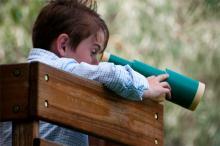
Visual perception is the ability to interpret and understand the information that comes through the eyes as a response to the light that shines in them. It is a dynamic process that identifies, organizes, interprets, and understands what is seen. It integrates sensory and motor information generated by the brain and body to derive meaning from it and direct movement.1
Visual perception is important for many functions. It guides motor behavior when catching a ball; interprets space and time; stores and recalls visual information for future use; and integrates information from other senses. Visual perception is a learned skill and is developed over time. The ability to interpret and understand what is seen is developed by integrating and using the information gathered, learning from it, and modifying the information by experience.2
Visual perception is a developing process during the early childhood years. Infants cannot focus at birth but by 2 and 3 months children can follow moving objects with their eyes. Babies have better eye-hand coordination at 4 to 6 months as significant advances have taken place in the vision centers of the brain. They can see more distinctly and move their eyes quicker and more accurately to follow moving objects. By 7 to 12 months young children are more mobile and developing a better awareness of their body and are learning how to coordinate vision with their body movements.3
At birth the eyeball is 65 percent of their adult size, but it does not reach its full size until the child is approximately 12 years of age. The macula of the retina is not completely developed until about 6 years of age and young children are generally farsighted. Because of this, young children have difficulty fixating on and intercepting moving objects.4
Visual spatial skills are a component of visual perception. They give the child the ability to perceive the relationship of space to his body as well as how he perceives objects in space in relation to other objects. This incorporates sight with the interpretation of the physical environment. If a child has poor visual spatial perception, he may bump into things, have difficulty getting from one place to another without getting lost, misjudge height and distance, and have difficulty catching a ball.5
On the playground, visual perception is a required skill for successfully using much of the playground equipment. When using overhead equipment, such as overhead ladders, rings, and monkey bars, children must judge the distance from one rung to the next and then coordinate their physical movements to reach the next rung. Eye-hand coordination is directly related to visual perception.6
- 1. “What is Vision? VisionandLearning.org. < http://www.visionandlearning.org/whatisvision08.html > 15 Sep. 2010.
- 2. Ibid.
- 3. “Your Infant’s Vision Development.” AllAboutVision.com. < http://www.allaboutvision.com/parents/infants.htm > 16 Sep. 2010.
- 4. Gallahue, David L. and Frances Cleland Donnelly. Developmental Physical Education for All Children. 4th ed. Champaign, IL: Human Kinetics. 2003. p. 31.
- 5. “Visual Spatial Perception.” Flinders University. < http://ehlt.flinders.edu.au/education/DLiT/2000/Motor%20Dev/visual.htm > 15 Sep. 2010.
- 6. Frost, Joe L., Pei-San Brown, John A. Sutterby, Candra D. Thornton. The Developmental Benefits of Playgrounds. Olney, MD: Association for Childhood Education International, 2004. p. 93.

